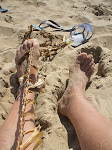Like much
of Britain
My thanks
go to Chris Dumont for helping to organise the twining one at Baltasound on Unst.
A small group, but hardly surprising given that several inter island ferries
had been cancelled due to the weather in preceding weeks, something that
happens rarely. People from the mainland of Shetland are understandably nervous
of getting stranded in the North Isles as there is little in the way of hotel accommodation
or eating places in either Unst or Yell at this time of year. The prospect of
spending the night in your car is therefore a real and not very appetising one.
Chris made
a kishie out of the fine polypropylene netting that crofters use on their bales
of silage. We had to devise some ways of weaving with it because, unlike straw,
this material made it difficult to differentiate the various strands making up
the hjogs. It worked in the end and he has used it to go shopping with.
Frame basketry is not part of the Shetland basketry tradition because there are few trees to make the frames out of. But, it is a good technique for people who enjoy textile weaving as the process is more akin to loom weaving than stake and strand basketry. It is also a great technique for using a wide variety of found materials. I don't normally do any preparation for students because I believe it is important for them to learn the whole process from gathering the material to completing the basket. But in this instance I made the frames out of willows from my garden in advance so that they could dry a bit, because flexible frames make controlling the shape much harder. However I did demonstrate how to make the frames so that they weren't missing out on that information and they had to make their own ribs. People brought along a wide variety of found materials including felted off-cuts from knitting machines, which was anew one for me and it worked really well. My thanks go to all the students at both workshops for making the effort to come and dragging themselves away from their warm houses.








